Comments / Questions (123)
![]() HUMEAU NADIA wrote:
HUMEAU NADIA wrote:
Bonsoir je bloque après avoir fait 3 fois en tout le schéma du petit gilet. Quand vous parlez d arrêter d augmenter sur les devants et le dos doit on avoir ces 259 mailles. Ce que je n ai pas !!j ai 238 Mailles si je ne me suis pas trompée. On continue d augmenter les emmanchures jusqu'à quand du coup. Merci pour votre aide.
18.09.2023 - 19:02DROPS Design answered:
Bonjour Mme Humeau, pour les manches vous devez augmenter d'abord 2 x 4 m (à intervalles réguliers) puis 17 x 2 m dans chaque manche soit 76 m au total; vous augmenter 6 mailles dans chaque diagramme soit 24 mailles à chaque motif en hauteur, x 3 fois en hauteur = 72 mailles. Vous aviez 111 mailles + 76+72= 259 mailles. Vous augmentez tous les rangs sur l'endroit pour les manches, soit 4 fois par diagramme en hauteur, après 3 motifs en hauteur, vous avez augmenté 12 fois, vous devez encore augmenter 5 fois pour les manches. Bon tricot!
19.09.2023 - 09:04
![]() Michele wrote:
Michele wrote:
Die ene steek waar de markeerdraad moet inkomen, wordt die dan gewoon recht gebreid?
13.09.2023 - 20:52DROPS Design answered:
Dag Michelle,
Ja, die steek brei je gewoon zoals je die voorheen breide.
18.09.2023 - 20:32
![]() Elli wrote:
Elli wrote:
Hihassa lisätään 4 tasaisin välein. Lisäksi tehdään raglanlisäykset. Myöhemmin viitataan, että jatka lisäyksiä kuten yllä. Jos tekee 4 joka oikealla kerroksella plus raglanit, hihasta tulee valtava. Miten se on tarkoitettu?
10.09.2023 - 17:04DROPS Design answered:
Hei, hihassa lisätään tasavälein 4 silmukkaa vain mallineuleen ensimmäisellä kerroksella. Tämän jälkeen tehdään ainoastaan raglanlisäyksiä.
19.09.2023 - 17:36
![]() Nadia HUMEAU wrote:
Nadia HUMEAU wrote:
Merci pour ces dernières explications. Je comprend mieux le schéma ainsi. Toujours aussi ravie de toutes vos interventions quand un problème se pose. Affaire résolue !! Merci
07.09.2023 - 07:43
![]() Nadia HUMEAU wrote:
Nadia HUMEAU wrote:
Merci milles fois pour vos réponses instantanées. Le soucis pour continuer ce travail est pour moi que je n arrive pas à calculer si j ai bien le nombre de Mailles pour cette taille 2 ans sur le 1er rg. J ai bien compris les marqueurs... Mais en ce qui concerne les manches ? Vous notez 12 Mailles avec 4 augmentions donc si je comprends bien entre chaque marqueur c'est 16 m sans les jetées ? Désolée 🙏
06.09.2023 - 11:39DROPS Design answered:
Bonjour Mme Humeau, tricotez le 1er rang des manches ainsi sur l'endroit en augmentant pour le raglan: tricotez 1 maille endroit et mettez un marqueur dans cette maille, 1 jeté (pour le raglan), tricotez 12 mailles endroit en augmentant 4 mailles , 1 jeté (pour le raglan), tricotez 1 maille endroit et mettez un marqueur dans cette maille => vous avez placé 1 marqueur au début et à la fin des manches et augmenté 4 m dans la manche + 2 m pour le raglan; je vais demander à ajouter cette précision pour les augmentations du raglan des manches. Bon tricot!
06.09.2023 - 15:52
![]() Nadia HUMEAU wrote:
Nadia HUMEAU wrote:
Merci pour vos renseignements. J ai remis sur papier. Lorsque l on met le marqueur sur la maille est ce que cette maille est considérée comme 1 augm supplémentaire en plus de la jetée ou fait elle partie des augmentations des rangs A4 et A3. Merci
05.09.2023 - 17:35DROPS Design answered:
Bonjour Mme Humeau, lorsque l'on met un marqueur dans une maille, c'est pour délimiter des zones précises, cette maille n'est pas une augmentation, c'est juste une maille à tricoter par la suite à l'endroit - ces mailles avec un marqueur se trouvent au début et à la fin des deux manches, pas dans les diagrammes qui se tricotent sur le dos et les devants. Bon tricot!
06.09.2023 - 08:47
![]() HUMEAU NADIA wrote:
HUMEAU NADIA wrote:
Bonjour je me oerdvy' peu dans les explications de ce petit gilet. Dois je commencer après le col par la partie empiècement comme je vois plus loin les explications dos devant avec pour 2vans 169m. Aussi quand je dois augmenter 4 Mailles pour la manche au départ sont elles en plus des 12 ? Pouvez vous me dire sur ce 1ervrang du coup combien je devrais avoir de Mailles pour avoir un repère. Merci mille fois
05.09.2023 - 08:17DROPS Design answered:
Bonjour Mme Humeau, vous tricotez d'abord le COL (2 cm de côtes avec 6 mailles de bordure devant de chaque côté sur les 111 mailles en 2 ans), puis vous tricotez la partie EMPIÈCEMENT: vous tricotez les différents diagrammes en augmentant comme indiqué dans les diagrammes A.3 et A.4 (devants et dos) et sous RAGLAN pour les manches. Au 1er rang des diagrammes, vous augmentez 8 mailles au total = 1 m dans chaque A.3 et A.4 (fin du devant gauche + début/fin du dos + début devant droit) + 2 m pour chaque manche. Bon tricot!
05.09.2023 - 14:03
![]() Cora De Jongh wrote:
Cora De Jongh wrote:
Ik vind het erg jammer, maar dit patroon is niet te lezen. Diverse malen geprobeerd (en lezen, lezen en nog eens lezen) maar hier kom ik ondanks jaren brei-ervaring echt niet uit. Slecht geschreven, geen goede ervaring met dit patroon.
28.08.2023 - 19:54
![]() Rikke wrote:
Rikke wrote:
Hej Drops! Vil I være søde at svare på mit spørgsmål fra d. 18.06.23.? Jeg kan ikke komme videre med projektet og har forsøgt som Anna at trylle med mønsteret selv uden gunstigt udfald.
13.07.2023 - 09:12DROPS Design answered:
Hei Rikke. Beklager at du ikke har fått svart tidligere, men du hadde lagt ditt spørsmål som en Kommentar når du har sendt inn, og ikke som et Spørsmål. Kommentarer blir ikke besvart. Oppskriften er videresendt til design avd. men de er nå på ferie, men vil svare så snart de kan. Men ta gjerne kontakt med en butikk som selger DROPS garn, de kan også hjelpe. mvh DROPS Design
24.07.2023 - 15:09
![]() Ginette wrote:
Ginette wrote:
Je fais la taille 6/9mois
05.07.2023 - 13:11DROPS Design answered:
Bonjour Ginette, donc vous avez 93 mailles que vous tricotez ainsi: 6 m point mousse, 7 m de A.1, et 5 m de A.3 (18 m pour le devant gauche), puis 1 m end avec 1 marqueur (1 m raglan), puis 12 m end (+ 4 = 16 m pour la manche gauche), 1 m end avec 1 marqueur (1 m raglan), puis 6 m de A.4, 3 x les 6 m de A.2 et les 5 m de A.3 (6+18+5=29 m pour le dos) puis 1 m end avec 1 marqueur (1 m raglan), puis 12 m end (+ 4 m = 16 m pour la manche droite), 1 m end avec 1 marqueur (1 m raglan), et enfin les 6 m de A.4, les 6 m de A.5 et 6 m point mousse (= 17 m pour le devant droit) soit: 18 +1+12+1+29+1+12+1+18=93 m (sans les augmentations). Bon tricot!
05.07.2023 - 13:42
Cotswolds Cardigan#cotswoldscardigan |
||||||||||||||||||||||
 |
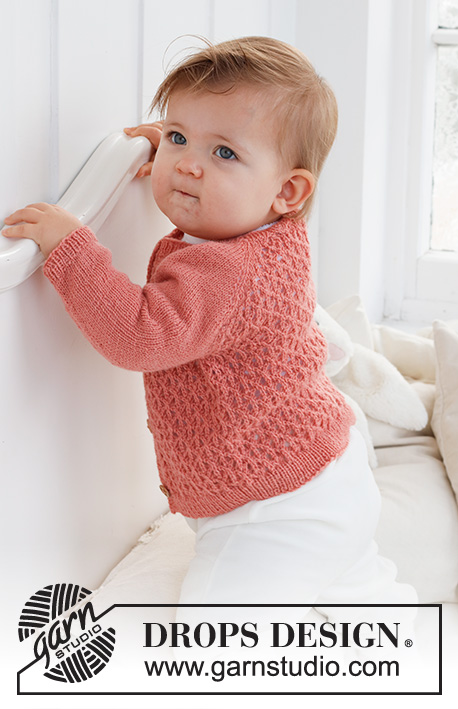 |
|||||||||||||||||||||
Knitted jacket for baby in DROPS Flora. The piece is worked top down, with raglan and lace pattern. Sizes 0 – 2 years.
DROPS Baby 43-2 |
||||||||||||||||||||||
|
------------------------------------------------------- EXPLANATIONS FOR THE PATTERN: ------------------------------------------------------- RIDGE/GARTER STITCH (worked back and forth): Knit all rows. 1 ridge = knit 2 rows. PATTERN: See diagrams A.1 to A.5. The diagrams show all rows in the pattern from the right side. BUTTONHOLES: Work buttonholes on the right band (when the garment is worn). Work from the right side when there are 4 stitches left on the row as follows: Make 1 yarn over, knit 2 together and knit 2. On the next row (wrong side), knit the yarn over to leave a hole. The first buttonhole is worked right after the neck. Then work the other 4 buttonholes with approx. 4½-4½ 5-5½-6 cm between each one. RAGLAN: All increases are worked from the right side! On the front and back pieces the increases are included in the diagram. Increase as follows on the sleeves: Increase 1 stitch after markers 1 and 3. Knit the marker-stitch, make 1 yarn over. Increase 1 stitch before markers 2 and 4. Work as far as the marker-stitch and make 1 yarn over, knit the marker-stitch. On the next row purl the yarn overs twisted to avoid holes! Repeat this increase every row from the right side a total of 10-12-14-16-17 times. DECREASE TIP (for sleeves): Decrease 1 stitch on either side of the marker as follows: Work until there are 3 stitches left before the marker, knit 2 together, knit 2 (marker sits between these 2 stitches), slip 1 stitch as if to knit, knit 1 and pass the slipped stitch over the knitted stitch. ------------------------------------------------------- START THE PIECE HERE: ------------------------------------------------------- JACKET – SHORT OVERVIEW OF THE PIECE. The neck and yoke are worked back and forth with circular needle, top down. The yoke is divided for body and sleeves and the body continued back and forth with circular needle. The sleeves are worked in the round with double pointed needles. NECK: Cast on 93-93-93-111-111 stitches with circular needle size 2.5 mm and DROPS Flora. Purl 1 row from the wrong side with 6 band stitches in GARTER STITCH – read description above, on each side. Then work rib as follows: 6 band stitches in garter stitch, * knit 1, purl 1 *, work from *-* until there are 7 stitches left, knit 1 and 6 band stitches in garter stitch. Work this rib for 2 cm. Change to circular needle size 3 mm. YOKE: Work the BUTTONHOLE on the right band – read description above! On the first row from the right side insert 4 markers and work as follows: Front piece: 6 band stitches in garter stitch, work A.1, then A.2 0-0-0-1-1 time, A.3. Sleeve: Insert marker 1 in the next stitch, work 12 stitches in stocking stitch and increase 4 stitches evenly over these stitches, insert marker 2 in the next stitch. Back piece: Work A.4, A.2 3-3-3-4-4 times, then A.3. Sleeve: Insert marker 3 in the next stitch, work 12 stitches in stocking stitch and increase 4 stitches evenly over these stitches, insert marker 4 in the next stitch. Front piece: Work A.4, A.2 0-0-0-1-1 time, A.5 and 6 band stitches in garter stitch. Continue this pattern on the next row from right side start to increase for sleeve – read description above. REMEMBER THE KNITTING TENSION! When A.1 to A.5 are completed, work the next row from the right side as follows: 6 band stitches in garter stitch, work A.1, A.2 1-1-1-2-2 times, A.3, work stocking stitch and increase as before over the sleeve as far as marker 2, work A.4, A.2 5-5-5-6-6 times, A.3, work stocking stitch and increase as before over the sleeve as far as marker 4, work A.4, A.2 1-1-1-2-2 times, A.5 and 6 band stitches in garter stitch. Repeat this pattern in height. Each time A.3 and A.4 are repeated in height, there is room for 1 more repeat of A.2 on the front pieces and 2 more repeats on the back piece. When A.3 and A.4 have been worked 2-2-3-3-3 times in height, the increases are finished on the front and back pieces; continue increasing only on the sleeves as explained above. Continue the pattern on the front and back pieces, but without further increases. When all the increases are finished there are 189-197-229-255-259 stitches. Now work pattern as follows: 6 band stitches in garter stitch, A.1 over 7 stitches, A.2 3-3-4-5-5 times, work 37-41-45-49-51 stitches in stocking stitch, A.2 9-9-11-12-12 times, work 37-41-45-49-51 stitches in stocking stitch, A.2 3-3-4-5-5 times, A.5 and 6 band stitches in garter stitch. Continue this pattern. When you work round 5 in A.2 on the back piece, knit the first stitch in the first repeat, the last stitch in the last repeat is worked over the first stitch on the sleeve. When the piece measures 12-13-14-15-16 cm from the cast-on edge, divide for the body and sleeves as follows: 6 band stitches in garter stitch, work 25-25-31-37-37 stitches as before, place the next 37-41-45-49-51 stitches on a thread for the sleeve, cast on 6 stitches under the sleeve, work 54-54-66-72-72 stitches, place the next 37-41-45-49-51 stitches on a thread for the sleeve, cast on 6 stitches under the sleeve, work 24-24-30-36-36 stitches as before and 6 band stitches in garter stitch. BODY: = 127-127-151-169-169 stitches. Continue back and forth as follows: 6 band stitches in garter stitch, work A.1, A.2 until there are 12 stitches left, work A.5 and 6 band stitches in garter stitch. When the piece measures 9-12-13-15-17 cm from the division, increase 20-20-22-26-26 stitches evenly spaced on the next row from the right side (do not increase over the bands) = 147-147-173-195-195 stitches. Change to circular needle size 2.5 mm and work rib from the wrong side as follows: 6 band stitches in garter stitch, * purl 1, knit 1 *, work from *-* until there are 7 stitches left, purl 1 and 6 band stitches in garter stitch. Continue this rib for 3 cm. Cast off. The jacket measures approx. 24-28-30-33-36 cm from the shoulder down. SLEEVES: Place the 37-41-45-49-51 stitches from the thread on the one side of the piece on double pointed needles size 3 mm and knit up 1 stitch in each of the 6 stitches cast on under the sleeve = 43-47-51-55-57 stitches. Insert a marker thread in the middle of the new stitches under the sleeve. Start at the marker and work stocking stitch in the round for 1 cm. Now decrease 2 stitches under the sleeve – read DECREASE TIP. Decrease like this every 2½-2-2-2-2½ cm a total of 3-5-6-7-8 times = 37-37-39-41-41 stitches. When the sleeve measures 10-12-15-16-22 cm from the division increase 5 stitches evenly spaced = 42-42-44-46-46 stitches. Change to double pointed needles size 2.5 mm and work rib (knit 1, purl 1) for 3 cm. Cast off with knit over knit and purl over purl. The sleeve measures approx. 13-15-18-19-25 cm from the division. Work the other sleeve in the same way. ASSEMBLY: Sew the buttons onto the left band. |
||||||||||||||||||||||
Diagram explanations |
||||||||||||||||||||||
|
||||||||||||||||||||||
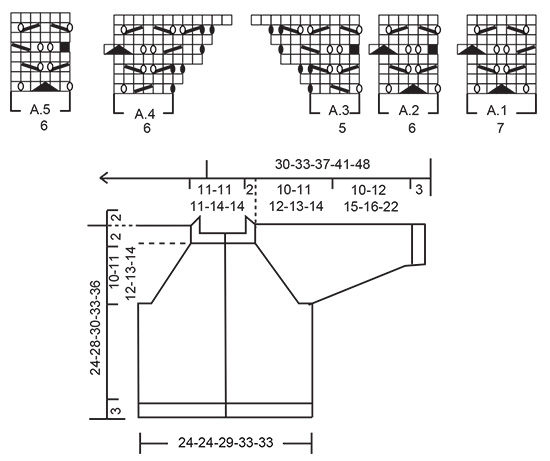 |
||||||||||||||||||||||
Have you finished this pattern?Tag your pictures with #dropspattern #cotswoldscardigan or submit them to the #dropsfan gallery. Do you need help with this pattern?You'll find 30 tutorial videos, a Comments/Questions area and more by visiting the pattern on garnstudio.com. © 1982-2025 DROPS Design A/S. We reserve all rights. This document, including all its sub-sections, has copyrights. Read more about what you can do with our patterns at the bottom of each pattern on our site. |
||||||||||||||||||||||







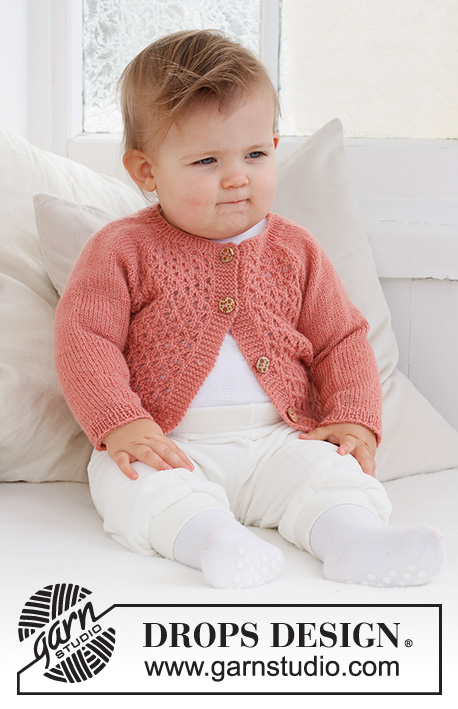
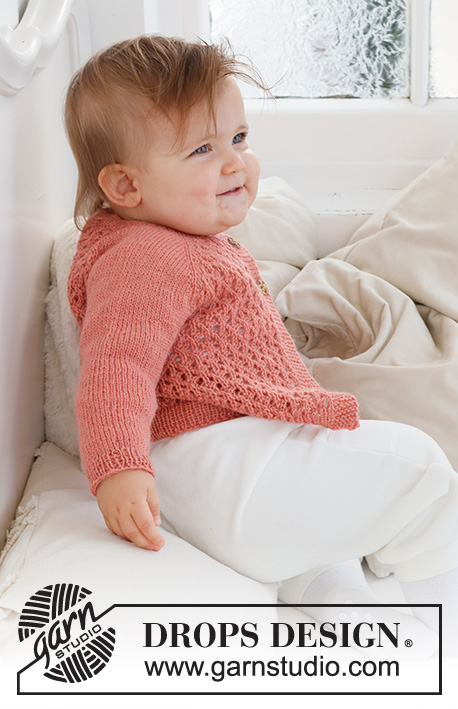
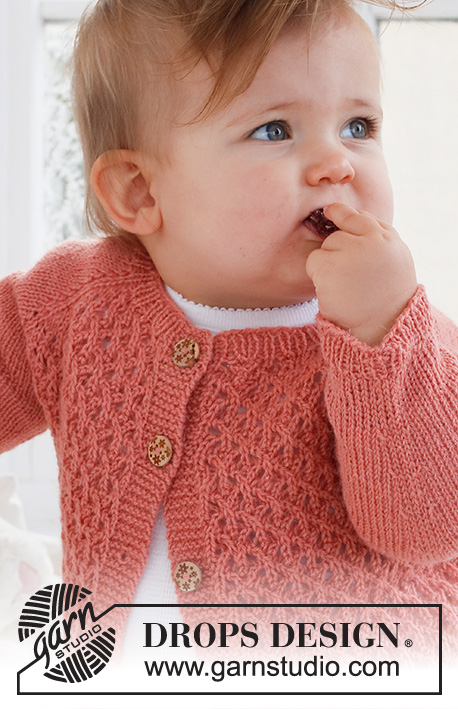

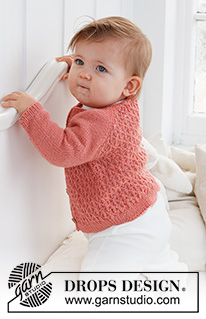
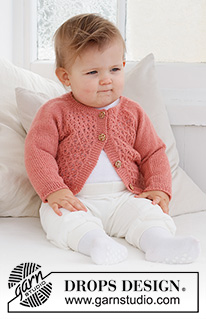
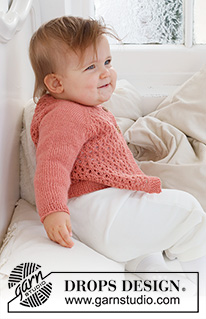
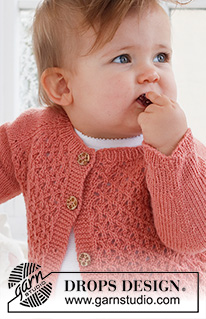






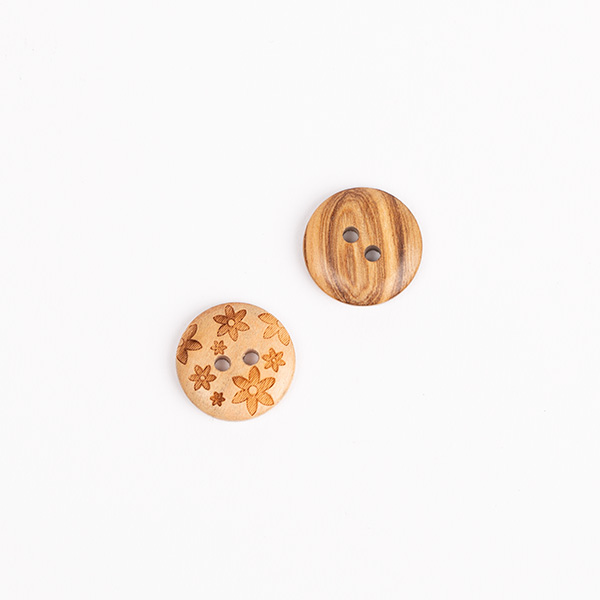

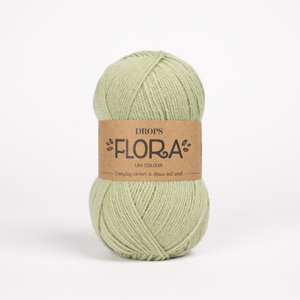
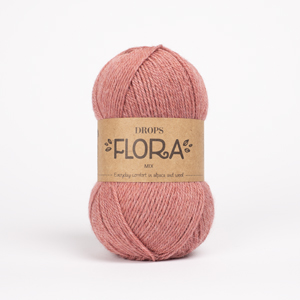
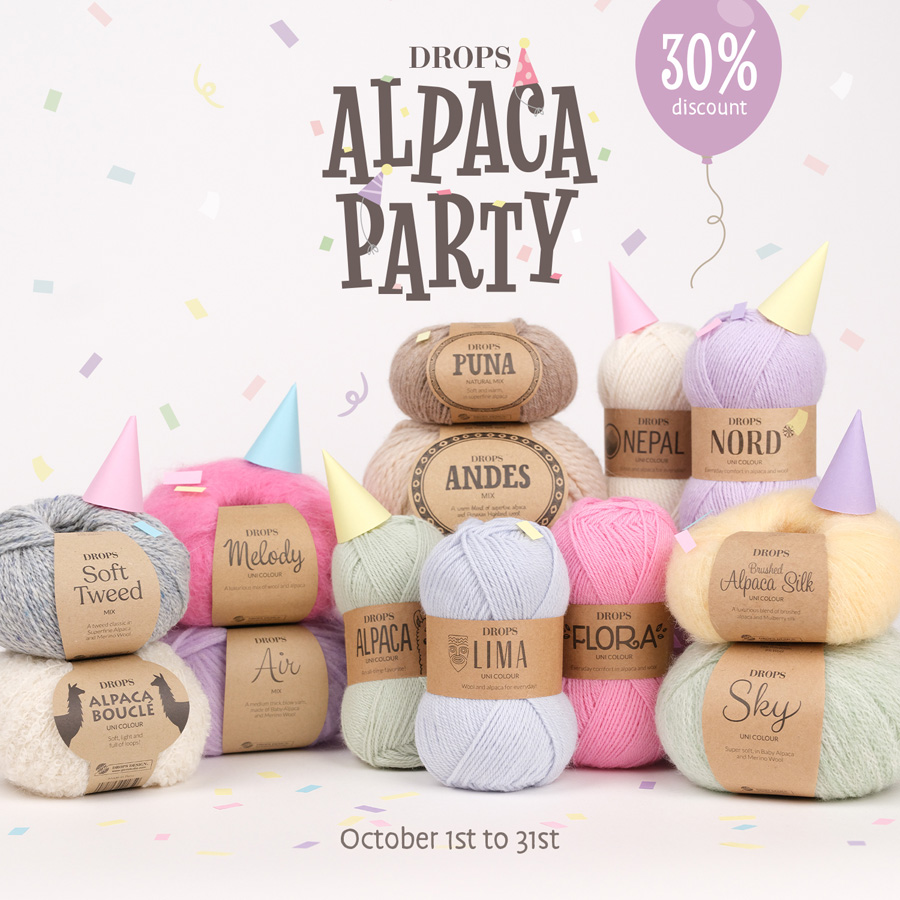
























































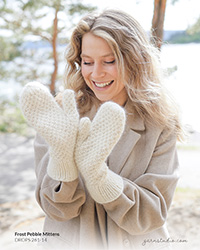

Post a comment to pattern DROPS Baby 43-2
We would love to hear what you have to say about this pattern!
If you want to leave a question, please make sure you select the correct category in the form below, to speed up the answering process. Required fields are marked *.